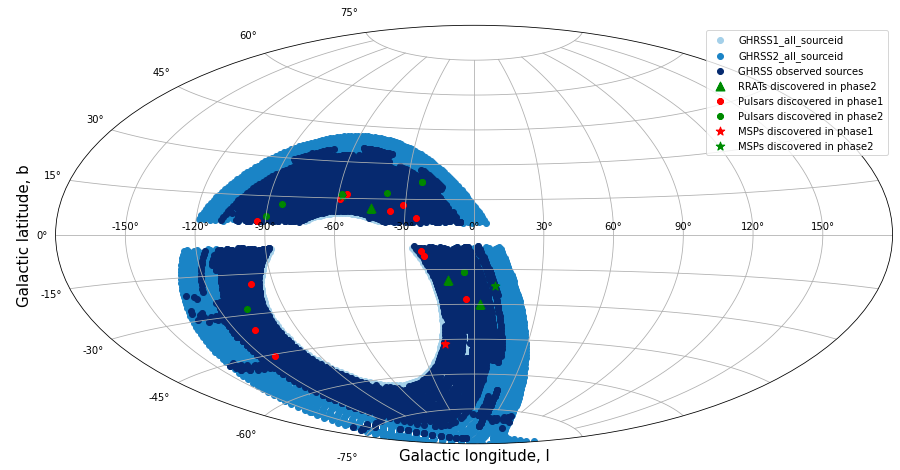The GMRT High Resolution Southern Sky (GHRSS) survey is an ongoing blind survey for pulsars and radio transients that scans the southern sky visible from the Giant Meterwave Radio Telescope (GMRT). The sky coverage of the survey has been plotted below. The survey has two distinct phases: Phase 1, which used the legacy GMRT system with a 32 MHz bandwidth, centered at 322 MHz, and Phase 2, which is still ongoing, and uses the upgraded GMRT system, with a 200 MHz bandwidth, centered at 400 MHz.
GHRSS survey sky coverage and discoveries: Part of the target sky that has already been covered by the survey is marked as a deep blue shaded region. Part of the sky that has not yet been covered by the survey is marked as a light blue shaded region. Image Credit : Shreya Prabhu (NIUS student).
- Bhaswati Bhattacharyya (NCRA)
- Jayanta Roy (NCRA)
- Ben W. Stappers (University of Manchester)
- Michael Keith (University of Manchester)
- Mateusz Malenta (University of Manchester)
- Maura A. McLaughlin (Univ. of West Virginia)
- Paul S. Ray (Naval Research Laboratory)
- Scott M. Ransom (National Radio Astronomy Observatory)
- Jayaram N. Chengalur (NCRA)
- Andrew G. Lyne (University of Manchester)
- Sanjay Kudale (NCRA)
- Ujjwal Panda (NCRA)
- Shubham Singh (NCRA)
- Wes Armour (University of Oxford)
- Karel Adámek (Silesian University)
- Shyam Sunder (NCRA)
- Sangeeta Kumari (NCRA)
- Search for pulsars and transients with the GMRT.
- Time-domain Astronomy with the GMRT: uGMRT to eGMRT.
- Post-correlation beamformer for time-domain studies of pulsars and transients
- The GHRSS Survey; Paper I: Survey description and initial discoveries.
- The GHRSS Survey; Paper II: New discoveries, timing and polarization properties
- The GHRSS Survey; Paper III: Searching for long period pulsars.
- The GHRSS Survey; Paper IV: Discovery of 4 new pulsars with an FFA search.
The table below lists all discoveries from the GHRSS survey; out of these, Phase 1 accounts for 13 discoveries, while Phase 2 accounts for 14 discoveries till now. A total of 31 discoveries has been made via the survey, which includes 2 MSPs, 2 mildly recycled pulsars, and 3 RRATs (a.k.a. rotating radio transients).
| Name | Type | Period (ms) | DM (pc/cc) | Flux density(mJy) |
|---|---|---|---|---|
| J0418-4154 | PSR | 757.11 | 24.5 | 10.3 |
| J0514-4407 | PSR | 320.7 | 15.4 | 9.7 |
| J0600-46 | PSR | 798.8 | 50.36 | 10 |
| J0702-4956 | PSR | 666.66 | 98.7 | 15.7 |
| J0919-42 | PSR | 812.6 | 57 | 6.4 |
| J0941-43 | PSR | 447.7 | 105.5 | 2.3 |
| J1023-43 | PSR | 454.3 | 62.7 | 1.6 |
| J1239-48 | PSR | 653.89 | 107.6 | 0.4 |
| J1242-46 | PSR | 1411.3 | 76.5 | 12 |
| J1243-47 | MSP | 5.31 | 78.6 | 0.9 |
| J1245-52 | PSR | 835.39 | 86.3 | 1 |
| J1255-46 | mildly recycled | 52.0 | 42.9 | 0.8 |
| J1406-50 | RRAT | - | 40 | - |
| J1428-42 | PSR | 234.7 | 66.0 | 1.8 |
| J1447-50 | PSR | 960.2 | 107.8 | 0.7 |
| J1456-48 | PSR | 536.81 | 133.0 | 1.2 |
| J1516-43 | mildly recycled | 36.02 | 70.25 | 0.7 |
| J1517-31 | PSR | 1103.7 | 61.7 | 0.32 |
| J1517-31 | PSR | 140.67 | 51.0 | 0.7 |
| J1559-44 | PSR | 1169.89 | 122.0 | 1.7 |
| J1708-52 | PSR | 449.62 | 102.6 | 1.4 |
| J1726-52 | PSR | 631.84 | 119.7 | 0.7 |
| J1810-42 | PSR | 532.20 | 104.9 | 1.5 |
| J1845-40 | PSR | 324.18 | 68.4 | - |
| J1845-40 | RRAT | 373.48 | 47.8 | - |
| J1850-48 | RRAT | - | 23 | - |
| J1936-30 | PSR | 1.6758 | 42.3 | 0.8 |
| J1947-43 | PSR | 180.94 | 29.9 | 4.7 |
| J2004-38 | RRAT | - | 23 | - |
| J2059-48 | MSP | 9.48 | 25.04 | - |
| J2144-5237 | MSP | 5.04 | 19.0 | 1.6 |
